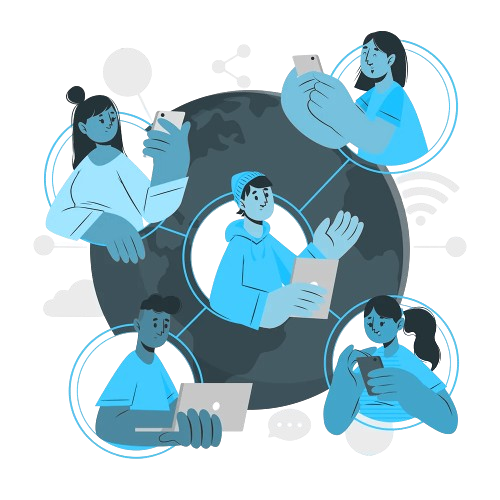Designing digital experiences that are easy to use is of utmost importance. Figma is a specialized tool for achieving this goal, and a workshop conducted by Binate Digital was exclusively dedicated to it. The workshop aimed to enhance the understanding of Figma for both new and experienced designers. To lead the session, we had the honor of inviting Mr. Umair Shamim Farrooqui, a renowned UI/UX expert from OSN, UAE, to inspire and enlighten both the young and experienced designers at Binate Digital.

Mr. Umair Shamim Farooqui addressing the employees of Binate Digital
A Place to Get Creative
Figma is more than just a regular tool for designing; it’s kind of like a special canvas where you can let your creativity run wild. Imagine it as a magical space where you can create cool things. It’s really helpful for designers because they can work on their projects as a team, even if they’re really far away from each other. This teamwork tool is fantastic for designing, and it comes in handy when teams are spread all across the world. So, even if you’re in one place and your design buddy is in another, you can still work together as if you’re in the same room.
Learning About Figma
During the workshop, we got to know more about how Figma works, especially for making things like buttons and icons on screens. Figma is easy to use because it has a clear setup that makes it simple for designers. It comes with many helpful tools, such as a toolbar that’s easy to reach and a layers panel that helps organize the different parts of a design. These tools make designs look even nicer and more effective.
Making Designs Perfect
We discovered that using something called “artboards” and “frames” is really helpful when creating designs for screens. These artboards and frames are like special areas where we can put our design ideas. They’re like planning spaces that help us figure out how people will use our design. It’s not only about making things look good; it’s also about making sure that people can understand and use the design without any problems.
Designing for People
In the Figma workshop, we discovered that designers have some special tools at their disposal when using Figma. It is like a digital toolbox that helps designers craft icons, buttons, and various elements that users can easily recognize and use. These tools allow designers to shape these elements in ways that make them clear and understandable for people.
Colors Are Important
Colors do more than just make things look nice; they also affect how people feel when they use a design. Imagine if a website or app had bright red colors everywhere. It might make you feel excited or even a little overwhelmed. On the other hand, soft blue colors might make you feel calm and relaxed.
Components: The Building Blocks of Consistency
UI components are the unsung heroes of design consistency, and Figma gave them their spotlight. Participants grasped the significance of these reusable design elements and how they maintain a seamless look across screens. The workshop delved into creating component libraries, ensuring efficiency and reducing redundancy in the design process.

The session was both interactive and informative
Navigating User Flows with Finesse
Design is interactive, and Figma’s interactive prototyping capabilities were the star of the show. Participants saw their designs come to life as they crafted transitions and micro-interactions that mimic real-world interactions. It was a lesson in transforming static designs into dynamic experiences, catering to user needs and behaviors.
From Feedback to Perfection
No design journey is complete without feedback, and Figma has that covered, too. The workshop underscored the art of user testing and feedback gathering through Figma’s prototyping feature. The iterative design process was laid bare, showing how feedback helps shape designs that are intuitive, effective, and user-oriented.
A Tapestry of Collaboration
The essence of teamwork and collaboration was truly exemplified as the session explored Figma’s collaborative features. Real-time design reviews and comments turned the design process into a collective endeavor, where ideas flowed seamlessly, and improvements were made collaboratively.
Advanced Techniques: Navigating the Design Landscape
As the workshop reached its peak, advanced techniques like constraints and Auto Layout were introduced. These techniques offer designers a toolkit to tackle complex layouts and ensure designs remain coherent across different devices. The session also highlighted the practical application of responsive design principles within Figma, ensuring that designs adapt gracefully to various screen sizes.
From Learning to Discussion
The session took a delightful turn as participants engaged in a lively design discussion. Questions were answered, doubts were clarified, and ideas were exchanged. This interactive segment fostered a sense of community and shared learning.
Sharing the Vision, Seeking Improvement
Participants presented their own design solutions, embracing constructive critique from their peers. This peer review session wasn’t just about showcasing skills; it was an opportunity for growth, where designers learned to view their work from fresh perspectives.

Mr. Umair imparting UI/UX wisdom
Fueling the Learning Journey
As the workshop concluded, participants were armed with more than just newfound knowledge. Resources ranging from UI/UX design references to Figma plugins and online courses were shared, ensuring that the learning journey doesn’t stop here.
In Conclusion: A New Design Horizon
The Figma Workshop Session organized by Binate Digital was a celebration of creativity, collaboration, and growth. From understanding the Figma interface to delving into advanced techniques, participants embarked on a journey that transcended mere design tools.

Employees were acknowledged for their participation in the session
Figma’s role in shaping user-centered, visually pleasing, and efficient digital experiences became evident, and attendees left the workshop with a renewed passion for UI/UX design. As they continue honing their skills, armed with Figma’s capabilities, a new design horizon unfolds – one that’s vibrant, dynamic, and filled with endless possibilities.


